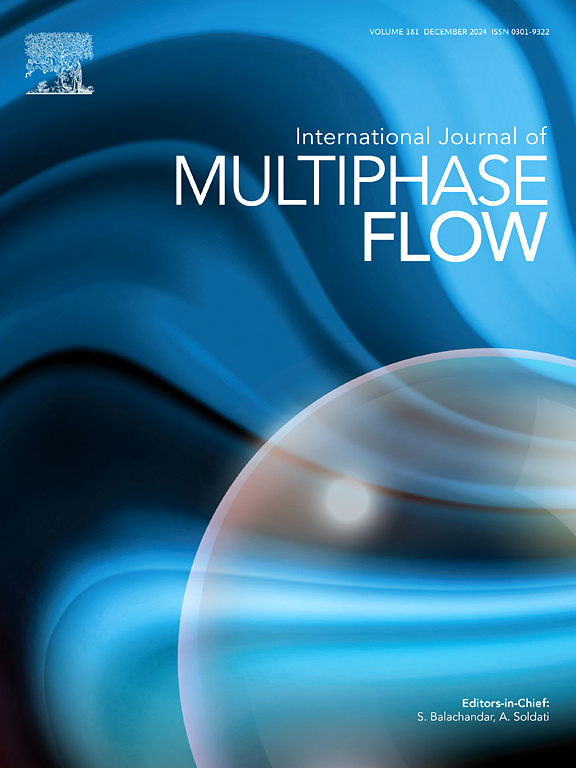Linking lacunarity to inertial particle clustering: Applications in solar photovoltaics
IF 3.6
2区 工程技术
Q1 MECHANICS
International Journal of Multiphase Flow
Pub Date : 2025-03-16
DOI:10.1016/j.ijmultiphaseflow.2025.105218
引用次数: 0
Abstract
The presence of wind-flung debris is inevitable in solar photovoltaic (PV) systems, negatively altering production and lifespan by way of adhesion (i.e. soiling) and forceful particle impacts. The propensity and magnitude of particle-to-panel interactions is largely dependent on environmental and panel-invoked turbulence, ultimately dictating local debris concentration and trajectories. This study confronts the mechanisms leading to PV panel soiling by developing a lacunarity-based framework for particle heterogeneity quantifying preferential concentration within asymmetric panel wakes due to inertial coupling. Drawing from established studies in multi-phase homogeneous isotropic turbulence (HIT), presented analysis demonstrates lacunarity as a comparable measure to Voronoï distributions for understanding particle clustering. Considering benchmark data obtained in experimental particle-laden HIT flow, global particle heterogeneity is shown to correlate with and dependencies observed through Voronoï tessellations. Further expanding to consider PV panel wakes, Voronoï analysis and lacunarity uncover location-dependent variations in local particle clustering relating to asymmetric turbulent wake features. In total, this work represents a novel perspective of characterizing particle-laden turbulent flow by way of lacunarity-based heterogeneity and motivates preferential concentration as a complex feature impacting particle trajectories in PV systems.

链接空隙与惯性粒子聚类:在太阳能光伏中的应用
在太阳能光伏(PV)系统中,风吹来的碎片的存在是不可避免的,通过粘附(即污染)和强力颗粒撞击的方式对生产和寿命产生负面影响。颗粒与面板相互作用的倾向和程度在很大程度上取决于环境和面板引发的湍流,最终决定了当地的碎片浓度和轨迹。本研究通过建立一个基于空白的颗粒非均匀性框架来量化由于惯性耦合导致的不对称面板尾迹中的优先浓度,从而研究导致光伏板污染的机制。从多相均匀各向同性湍流(HIT)中已建立的研究中,提出的分析表明,空隙性作为理解粒子聚类的Voronoï分布的可比措施。考虑到在实验颗粒负载HIT流中获得的基准数据,全局颗粒非均质性与通过Voronoï镶嵌观察到的Reλ和ϕv依赖关系相关。进一步扩展到考虑光伏板尾迹,Voronoï分析和空白揭示了与不对称湍流尾迹特征相关的局部颗粒聚类的位置依赖性变化。总的来说,这项工作代表了一种新的视角,通过基于缺位的非均质性来表征颗粒负载湍流,并激发了优先浓度作为影响PV系统中颗粒轨迹的复杂特征。
本文章由计算机程序翻译,如有差异,请以英文原文为准。
求助全文
约1分钟内获得全文
求助全文
来源期刊
CiteScore
7.30
自引率
10.50%
发文量
244
审稿时长
4 months
期刊介绍:
The International Journal of Multiphase Flow publishes analytical, numerical and experimental articles of lasting interest. The scope of the journal includes all aspects of mass, momentum and energy exchange phenomena among different phases such as occur in disperse flows, gas–liquid and liquid–liquid flows, flows in porous media, boiling, granular flows and others.
The journal publishes full papers, brief communications and conference announcements.

 求助内容:
求助内容: 应助结果提醒方式:
应助结果提醒方式:


